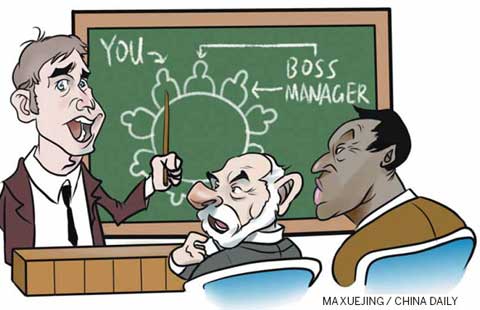Asia, China gaining on US in R&D
Updated: 2014-02-17 06:11
By Eliana Kirshenblat in New York (China Daily Latin America)
|
||||||||
The major Asian economies, taken together, perform a larger share of global research and development (R&D) than the US, according to a report released recently by the National Science Board (NSB).
China and South Korea are credited as being mainly responsible for this growth, having increased their innovation capacities in a short period of time. They have significantly invested in science and technology (S&T) enterprises and increased university training in those areas. China, specifically, performs nearly as much of the world's high-tech manufacturing as the US, the report said.
Since 2001, the share of the world's R&D performed in the US and Europe has decreased, respectively, from 37 percent to 30 percent and from 26 percent to 22 percent.
At the same time the share of worldwide R&D performed by Asian countries grew from 25 percent to 34 percent. China led the Asian expansion, with its global share growing from just 4 percent to 15 percent during this period, the report said.
Between 1995 and 2008 China tripled its number of researchers. South Korea doubled its number between 1995 and 2006.
There are also indications that students from these nations may be finding more opportunities for advanced education in science and employment in their home countries.
US dominance in science and technology has been in decline over the past decade. US R&D took its biggest hit in 2009 due to the recession. However the report claims the US bounced back better than other developed countries, like Japan and Europe, who are also behind China in R&D. The US is the only one of these countries to return to pre-downturn levels.
"The first decade of the 21st century continues a dramatic shift in the global scientific landscape," said NSB Chairman Dan Arvizu, who is also the director and CEO of the National Renewable Energy Laboratory.
"Emerging economies understand the role science and innovation play in the global marketplace and in economic competitiveness and have increasingly placed a priority on building their capacity in science and technology," Arvizu said.
There is also growing motivation for China and other Asian countries to invest more in green technology. China's air pollution has been worsening to the point that homemade air filters are a growing business, said an earlier China Daily report.
In 2012, China invested $61 billion in clean energy, serving as the "primary driver of investment" for emerging economies as a whole in this area. Nearly $100 billion in total was spent on clean energy, primarily wind and solar, by emerging economies.
On top of hugely increased investments, innovation capacity has also increased in emerging economies. According to the measures used by the NSB, this means that there is a growing workforce of experienced science and engineering workers, greater commitment to innovation, such as the educational focus that has been demonstrated by China and South Korea, and an increasing number of patents on new research and technologies.
This information points to upward trends that show no sign of slowing. And though the US, Japan and Europe's positions as world leaders in R&D are clearly challenged, the US remains the biggest spender in R&D research.
Ray Bowen, NSB member and chairman of its Committee on Science and Engineering Indicators, which oversees development of the report, said in a press release, "The United States remains the world's leader in science and technology. But there are numerous indicators showing how rapidly the world is changing and how other nations are challenging our predominance. As other countries focus on increasing their innovation capacities, we can ill afford to stand still. We now face a competitive environment undreamed of just a generation ago."

 World's largest freshwater lake frozen
World's largest freshwater lake frozen
 American photographer wins World Press Photo 2013
American photographer wins World Press Photo 2013
 Zhou Yang retains women's 1500m title
Zhou Yang retains women's 1500m title
 Renzi set to become Italy's youngest PM
Renzi set to become Italy's youngest PM
 Kissing contest celebrates Valentine's Day in Beijing
Kissing contest celebrates Valentine's Day in Beijing
 Xinjiang quake damage could have been worse
Xinjiang quake damage could have been worse
 US East Coast buried in snow
US East Coast buried in snow
 China's Li wins women's 500m gold
China's Li wins women's 500m gold
Most Viewed
Editor's Picks

|

|

|

|

|

|
Today's Top News
Shelters reveal flaws in child welfare
Precipitation expected to clear up smog-filled skies
Police reveal details of Xinjiang terrorist attack
Canadian immigration changes called unfair
Finding real wealth in health industry
Courts try to improve efficiency
Europe eyes new data network
Obama signs increase in US debt ceiling
US Weekly

|

|




